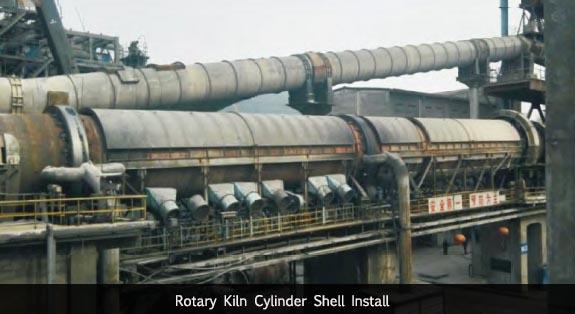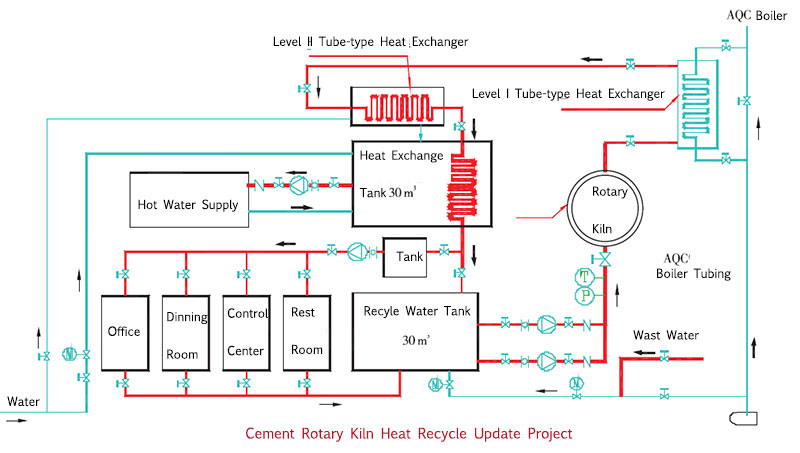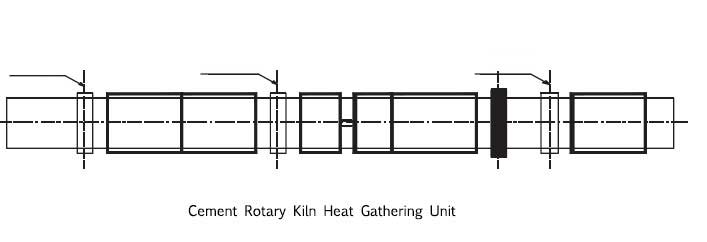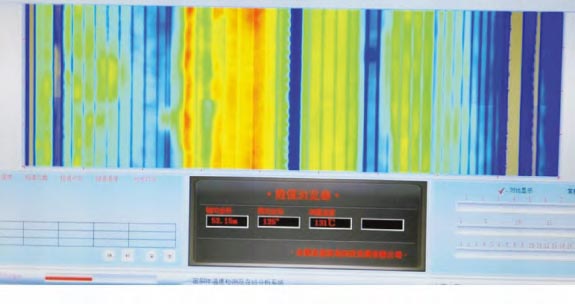How To Realize Heat Recycle In Clinker Production Plant
China is the world's largest cement production and consumer, which needs large amount of clinker production plant, and since China is a country lack of energy resources, in addition to making full use of waste gas waste heat power generation cement rotary kiln plant, cement rotary kiln shell surface radiation heat should be recycled and reused. For example, a 2 000 T/D special cement clinker production line in Qinghai was built and put into production at the beginning of 2010. How to effectively recycle waste heat is a new problem for energy saving.
Heat Recycle Project for Clinker Rotary Kiln
In June 2012, the 6MW waste heat generator set was put into operation, generating capacity of 80,000 to 100,000 kw per day. In order to further recovery of cement clinker production plant calcining heat loss of production, we analyzed the Φ 4 m by 60 m distribution characteristics of rotary kiln shell surface temperature, according to the control of rotary kiln shell surface temperature scanning and the measured data, our rotary kiln shell surface temperature is 230 ~ 350 ℃, locally as high as 400 ℃, cylinder forced air-cooled chiller or natural, heat by radiation and natural convection air directly into the atmospheric environment, this is the main waste of energy.

At the end of 2012, the cement plant manager decided to recover and utilize the radiation heat loss on the surface of the rotary kiln. This project by technical department to do the research and mannage the installation, the technology is mainly used by the arc set installed on clinker rotary kiln shell heat shields, with water as working medium, the use of waste heat boiler, waste water and shortfalls by the power supply of demineralized water treatment system, the circulating pump to set heat shields, cover the collection hot hot water temperature of 97 ℃ above, the first and the kiln head boiler feed water heat exchanger, improves the thermal efficiency of waste heat power generation system, and then with water heat exchanger for bathhouse, and then add a pump, for production office district heating in winter, cooling water back after the circulation water tank; Stop heating in summer, and tap water after heat exchange directly back to the circulation tank. It was installed during the overhaul in June 2014, and has been in operation for 3 years, which has achieved very good environmental and social benefits.
The recovering radiant heat from cement rotary kiln shell in clinker production process

Design of Heat Generating Cover for Rotary Kiln in Clinker Production
Qinghai 2 000 T/D special cement clinker production line designed by Chengdu Industrial Design and Research Institute of building materials was completed and put into production at the beginning of 2010. Rotary kiln is a kind of high energy consumption equipment, in the process of clinker calcining, the waste gas heat consumption accounts for about 30% of the dry kiln, the tube radiant heat consumption accounts for about 6% of the dry kiln .

Table bellow shows the heat required by each part of the rotary kiln system of the company (calibrated by school of Materials, Nanjing University of Technology). Under the call of the national policy of energy conservation and emission reduction, projects to recycle waste gas and heat from rotary kilns have been carried out widely, and considerable economic and environmental benefits have been achieved, such as waste heat power generation project configuration. Most of the surface temperature of the rotary kiln shell is between 230 ~ 350 ℃, and the heat is dissipated into the environment by radiation and natural convection. At present, this part of the heat has not been basically recycled, even if there is a small amount of use, is not very perfect. The surface heat dissipation of standing equipment such as kiln tail preheater, decomposing furnace and grate cooler can be reduced by using new-type and high-quality insulation materials as far as possible.
Heat Consumption Distribution of Clinker Production Process
| Section | Heat Consumption Details | |
|---|---|---|
| Rotary Kiln Heat Distribution of Sections (kj.kg-1) | Percentage(%) | |
| Evaporation of water |
52.92 |
1.43 |
| System Surface Heat Loss(Exclude Cylinder) | 348.77 | 9.44 |
| Rotary Kiln Heat Loss | 209.92 | 5.68 |
| Heat in Waste Gas | 1128.41 | 30.53 |
| Heat in Clinker | 149.98 | 4.06 |
| Heat Created by Clinker | 1805.41 | 48.86 |
| Heat Loss in Clinker Manufacture | 3695.33 | 100 |
Heat radiation is like light, when it strikes an object, it has the properties of reflection, penetration and absorption, the latter of which is converted back into heat energy. To recycle rotary kiln cylinder radiate heat loss, we analyzed the normal operation of equipment, tube in vitro table temperature distribution of calcining zone, cylinder surface in vitro have 6 sets of axial flow fan forced air cooling, transitional zone of natural cooling, cylinder surface temperature is monitored 24 h real-time by temperature scanner, with a local high temperature by field patrol duty personnel to use the infrared temperature measuring gun measure for emergency treatment.
Rotary Kiln Shell Scanning
A heat collector shell was installed outside the rotary kiln shell to recycle radiant heat. The heat collecting unit is arranged between two wheel belts of the rotary kiln shell. 900 mm inspection and maintenance distance is set aside on both sides of the wheel belt. The arc of the heat collecting unit is the concentric circle of the cement rotary kiln shell, and the inner diameter of the heat collecting cover is 200 mm from the shell surface. The heat exchange carrier is softened water, which is supplied by the waste water of SP waste heat boiler at the rotary kiln end and power generation water treatment system. The circulating water is provided with 30 m3 water storage tank and circulating water pump. The heat-absorbing 3 tube group is composed of several seamless steel tubes of medium pressure boiler, which are all distributed in 360° circle. In order to ensure heat exchange efficiency, the heat-absorbing tube surface is treated with high-temperature black paint as anticorrosion, to increase blackness and reduce reflectivity.

The radiant energy reflection panels on the outside of heat pipe, plate adopts the delta 0.5 mm stainless steel plate, it has the very high diffuse, make the heat pipe back has also been radiation energy reflection, with this method, further improve the absorption of heat tube heated area, can effectively recycling cylinder surface facing the heat radiation, reflection plate fixed in the collection of heat shields on steel keel on the inside of heat collector shell, and the shell body heat preservation material plate. The water from the circulating pump enters from the heat collector bottom, and the top outlet is designed to discharge the air and steam smoothly in the heat exchanger tube. All the heat collecting units are installed in series or parallel.
For the rotary kiln which USES infrared scanning thermometer to measure temperature, this completely closed recovery method makes it impossible to detect the surface temperature of the cement rotarykiln. Therefore, an infrared scanning longitudinal inspection mouth and a manual temperature measurement window are reserved in the design, to provide convenience for production operation, and not to affect the current operating conditions of the rotary kiln, the detection of external surface temperature of the cylinder. The main body of the heat exchanger is mounted on a bracket welded by channel steel. Here are tips of installation of heat collector of a rotary kiln of new building materials in Qinghai.
- The heat collector shell is installed on the outside of the rotary kiln. Although it is conducive to the recovery of heat radiation of the rotary kiln, it is a standing equipment and suspended installation. The rotary kiln is a rotary equipment, so it is inconvenient for installation and maintenance.
- Since the temperature distribution of the cylinder is not a constant parameter, the outlet water (or steam) temperature should be automatically detected, and inlet water flow should be adjusted to keep the outlet water (or steam) temperature basically constant.
- Due to the large heat exchange area, the heat energy generated by this has not been fully utilized.
- Other ways of using heat are being explored.
If you need any support in complete cement plant solutions or related cement production equipments, contact AGICO now for professional advices and latest price!

